|
12/19/2002 Entry: "Incisor Reduction"
Article from The Whole Horse Journal, July/August 1997. You may obtain a subscription
to The Whole Horse Journal by calling 1-800-829-5580.
All graphics are located here (opens in a new window) (ignore the graphic locations
which the article specifies - they are in place due to copyright laws).
Incisor Reduction
Who should perform this procedure?
As part of the process of taking care of our domestic horses' teeth, the length
and shape of the incisors must be addressed. Horse owners need to be aware, however, that their otherwise highly
trained veterinarian may not be fully qualified in this specialty area. As one source explains, a good dentist
may not happen to be a veterinarian and a good veterinarian may not be a dentist.
While incisor reduction is not technically difficult, caution must be taken in
its application because of its profound effect on whole mouth function, says Todd Williams, of Turner Valley, Alberta,
Canada, one of only 27 professionals throughout the world certified as a master dentist by the World Wide Association
of Equine Dentistry, Inc. (WWAED). Williams emphasizes that incisor reduction is an important dental procedure
but it should be used only as a part of full mouth care.
"Incisor reduction only works if the molar work has been done completely
and properly first," he cautions. "When some-one cuts the incisors down when there is a high tooth, abscessed
molar, or other sharp formation in the cheek battery, it drops the bite right down on the problem area and causes
the horse severe long term joint and mouth pain.
"Incisor overgrowth on its own is bad for the horses, but they have been
compensating gradually and are continuing to function," he says. "When a person who is poorly trained
in dentistry does incisor work improperly he can cause real damage, real fast. Because of the recent lectures and
one and two-day workshops on dentistry which are being taught at this time, professionals are being exposed to
the incisor reduction procedure without being thoroughly trained in whole mouth function. I am seeing some real
serious mistakes made in the field which has resulted in horses experiencing an increase in long-term pain and
dysfunction. " Williams insists that equine dentistry is very specialized and requires many hours of education
and hands-on work under the direct supervision of an experienced dentist. The WWAED provides education, certification
and testing for equine dentists whether they be licensed veterinarians or lay technicians.
"You can't learn dentistry in lectures or from a text, " Williams says.
"We require education, apprenticeship, testing for certification, and insist on continuing education. Because
of the danger of cutting the incisors before the molar arcade is properly balanced, it is one of the very last
procedures our dentists learn."
Veterinary Perspective
Dr. Mitch Benson is a veterinarian from Sonoma County, California who candidly
admits he knew very little about whole mouth dentistry until recent years. In addition to serving his busy equine
practice Benson has become nationally recognized for his work with endurance horses. He is currently head veterinarian
of a 15-veterinarian panel which monitors the health of horses competing in the famous Western States 100-mile
(Tevis Cup) ride. He is also the head veterinarian for the United States Equestrian Team (USET) endurance team
which competes internationally.
Despite these credentials and extensive experience, Benson was like most veterinarians
in the field: he received perhaps 10 hours of education on the horse's mouth during his formal training, and his
focus during his general practice dental care was on floating or filing the points of a horse's premolars and molars.
Only once in his career, which includes regularly attending professional meetings
and reading the latest veterinary research publications, had Benson heard of a dentistry procedure involving trimming
the horse's front teeth. Today, he feels a high percentage of the horses in our domestic population require full
mouth balancing and incisor reduction and realignment in order to maintain their health.
Benson realized this gap in his dentistry knowledge when he met and worked with
Williams.
"When I read the first article on incisor reduction it seemed very theoretical,
it didn't seem to make much sense," Benson says. "But when I spent time with Todd and he showed me the
relationship of the incisors to the function of the whole mouth, the importance became crystal clear. A high percentage
of horses in the general population have incisors which are too long because of the lack of grazing. This is causing
them serious problems."
Benson agrees education in the area of equine dentistry within the veterinary
profession has been lacking.
"There has been more published about equine dentistry in the last two years
than probably during the past 30," Benson says.
Most veterinarians have been taught to recognize some of the problems in the horse's
back teeth and address them by filing down or floating the sharp edges. As it turns out, this procedure may be
only a small percentage of what truly needs to be done within a domestic horse's mouth to keep him healthy. Because
of this lack of whole-mouth knowledge, many veterinarians and non-certified dentists do not understand the relationship
between problems with the front teeth and sharp edges in the back and vice versa.
Floating - Part Of The Story
This partial education not only leaves these professionals unqualified to perform
incisor reduction, but also creates another problem. When the horse's dental care only includes floating or filing
down portions of the cheek teeth without trimming the incisors, the difference between the length of the front
and back teeth is actually increased.
"Floating the cheek teeth is absolutely necessary," Benson says. "But
if the dental care only includes floating you are actually accentuating the difference in length and accelerating
the original problem.
"I've seen several instances where horses were not chewing well to the point
of losing weight even though they had been floated two to three times within one year," he explains. "The
cheek teeth had been addressed and shaped very well but the horses were not able to chew properly because their
incisors were too long and they prevented the molars from making contact.
"These horses had to wad their hay up into balls to get it even partially
chewed," Benson says. "When I reduced the incisors to where they had good cheek teeth contact they gained
weight quickly and became comfortable in their head and neck."
Don't Wait For Weight Loss
Contrary to what most horse owners have been taught, body weight is not an accurate indication of a horse's dental
health. While a horse may lose weight due to teeth problems, Benson warns owners not to assume their horses' teeth
are fine because they are holding their weight. Two factors of modern horse life, higher feed quality and relatively
low work demands, make it easier for horses to maintain their outer appearance even if their mouths are suffering.
"Equine dentistry was a much more important part of horse management and
care in the 1800s and early 1900s than it is to-day," he says. "When goods were moved by horses they
might work ten hours a day. Their caloric needs were tremendous, and they had to meet those needs by eating poor
quality hay and bushels of oats. The work horse had to be efficient with his feed and in order for that to happen
his teeth had to be right. Teeth problems in those horses showed up quickly as weight loss, a lack of energy, and
poor performance. It meant bankruptcy for the business owner."
In contrast, the pleasure horse of today might work only five to ten hours a week,
so he has a greatly reduced calorie requirement.
us to neglect the teeth," Benson explains. "If the horse is only processing
and digesting 50 percent of his food, you just feed him twice as much and he will come close to satisfying his
nutritional requirements. Most of the horses which I do major dental work on ~e not skinny horses, though they
may have a history of needing to be fed often or requiring a processed food like Equine senior in order to gain
or even maintain their weight.
I've seen horses with teeth that are so bad that the horses have lacerated cheeks
and cut tongues," Benson says. "They literally bleed every time they eat, but they still manage to eat
enough to look presentable. These days, it takes an awfully poor dental situation to result in an extremely skinny
horse."
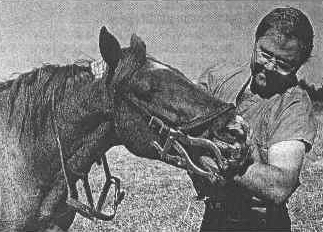
Todd Williams uses a full mouth speculum to hold the horse's mouth open while he reaches back to examine the molar
arcades.
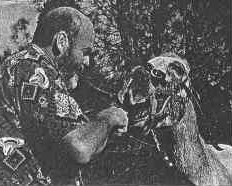
Dr. Mitch Benson files down sharp edges on Dancer's cheek teeth before he addresses her incisors.
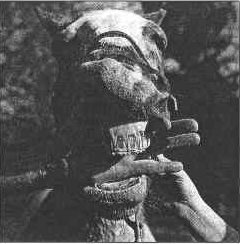
The line on Dancer's top incisors shows how much needs to be cut off. A similar amount will be taken off the corners
of the bottom incisors.
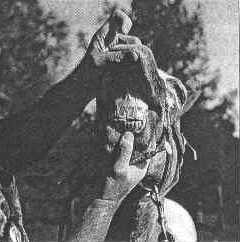
Three of the top incisors have now been shortened; three remain to be trimmed.
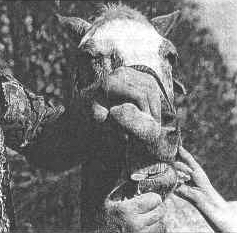
Dancer is heavily sedated to keep her still while Dr. Benson uses a diamond cutting wheel to cut off the part of
the tooth which is too long. The visible part of the teeth have no nerve supply so the pain of the procedure is
minimal.
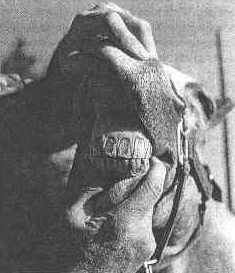
Dr. Benson has now reduced both top and bottom incisors so that they meet on a straight flat surface and allow
the molars to meet in a grinding motion. All that remains is some shaping on the left corner incisor.
Thanks to MITCH BENSON, D.V.M., Santa Rosa, CA, and TODD WILLIAMS, NVEq. D.
Turner Valley, Alberta, Canada, for their help with this article.
|


